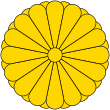
The politics of Japan are conducted in a framework of a multi-party bicameral parliamentary representative democratic constitutional monarchy whereby the Emperor is the ceremonial head of state and the Prime Minister is the head of government and the head of the Cabinet, which directs the executive branch.

The Democratic Party of Japan was a centrist political party in Japan from 1998 to 2016.

The Social Democratic Party, also known as the Social Democratic Party of Japan and previously as the Japan Socialist Party, is a political party that at various times advocated the establishment of a socialist Japan until 1996. Since its reformation and name change in 1996, it has defined itself as a social-democratic party.

The New Party Sakigake, also known as the New Harbinger Party, was a political party in Japan that broke away from the Liberal Democratic Party (LDP) on 22 June 1993. The party was created by Masayoshi Takemura. The party was centrist, and had many reformist and even moderate ecological elements. The theoretical leader was Shusei Tanaka. Yukio Hatoyama and Naoto Kan also took part but later moved to the Democratic Party of Japan.

A general election in Japan was held on 11 September 2005 for all 480 seats of the House of Representatives of Japan, the lower house of the Diet of Japan, almost two years before the end of the term taken from the last election in 2003. Prime Minister Junichiro Koizumi called the election after bills to privatize Japan Post were voted down in the upper house, despite strong opposition within his own Liberal Democratic Party (Japan) (LDP).

The People's New Party was a Japanese political party formed on August 17, 2005 in the aftermath of the defeat of Prime Minister Junichiro Koizumi's Japan Post privatisation bills which led to a snap election. On March 21, 2013 party leader Shozaburo Jimi announced that he was disbanding the party.
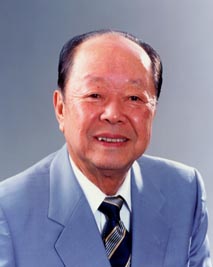
General elections were held in Japan on July 18, 1993 to elect the House of Representatives. The Liberal Democratic Party (LDP), in power since 1955, lost their majority in parliament. An eight-party coalition government was formed and headed by Morihiro Hosokawa, the leader of the Japan New Party (JNP).
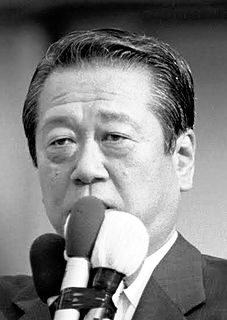
The 21st Elections to the House of Councillors for the upper house of the legislature of Japan were held on July 29, 2007. The date was originally to be July 22, but the ruling Liberal Democratic Party (LDP) decided in mid-June to extend the session of the House for a week to finish up legislative business; this step was criticised due to the short-term delay.

House of Councillors elections were held in Japan on July 8, 1956 electing half the seats in the House plus two vacant seats in the other half. The Liberal Democratic Party won the most seats, but failed to win a majority. It was the first national election under the 1955 System, approximately a two party system of Ichirō Hatoyama's Liberal Democratic Party (LDP) that was created in the "conservative merger" of 1955 and Suzuki Mosaburō's reunified Japan Socialist Party (JSP). The later dominant LDP failed to win a majority.

Elections for the Japanese House of Councillors were held in Japan on 29 July 2001. It was the first national election since Junichiro Koizumi was appointed as prime minister after Yoshiro Mori resigned in April 2001. The Liberal Democratic Party (LDP) and its election allies, were the major winner, provided Koizumi a strong mandates to move forward with his reform policies. The ruling coalition performed well, and regain their majority in the House of Councillors.

Elections for the Japanese House of Councillors were held in Japan in 1980. On 16 May 1980, the Japan Socialist Party (JSP) brought no-confidence motion before the Diet relating to corruption issues, proposing more defense spending and rises in public utility charges as reasons for the House of Representatives to withdraw its backing from the government. Unexpectedly, 69 Liberal Democratic Party (LDP) members of the Diet from the Fukuda Takeo, Miki Takeo and Hidenao Nakagawa factions abstained from voting on the motion. The government was defeated by 56 votes in total of 243 and resigned. For the first time elections for both the House of Councillors and the House of Representatives were called in June 1980. In the elections of both the houses the LDP gained a perfect majority.

Elections for the Japanese House of Councillors were held in Japan on July 12, 1998.
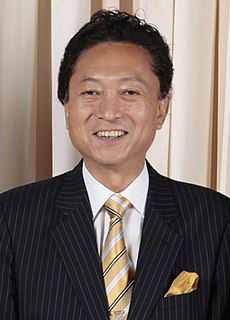
A general election for the Japanese House of Representatives was held on August 30, 2009. The opposition Democratic Party (DPJ) defeated the ruling coalition in a sweeping victory, winning 221 of the 300 electoral districts and receiving 42.4% of the proportional block votes for another 87 seats, a total of 308 seats to only 119 for the LDP.

The 22nd Elections to the House of Councillors for the upper house of the legislature of Japan were held on July 11, 2010. In the last election in 2007, the Liberal Democratic Party (LDP) lost its majority to the Democratic Party (DPJ), which managed to gain the largest margin since its formation in 1996. The House of Councillors is elected by halves to six-year terms. The seats up for election in 2010 were last contested in the 2004 election.

The 23rd Elections to the House of Councillors for the upper house of the National Diet, the legislature of Japan, was held on July 21, 2013. In the last election in 2010, the Democratic Party of Japan (DPJ) remained the largest party, but the DPJ-led ruling coalition lost its majority. The House of Councillors is elected by halves to six year terms. In 2013, the class of Councillors elected in 2007 was up.

The Murayama Cabinet governed Japan under the leadership of Prime Minister Tomiichi Murayama from 1994 until a 1995 Cabinet Reshuffle. Murayama was elected prime minister by the National Diet on 29 June 1994 after the threat of a no-confidence vote had brought down the previous minority Hata Cabinet. Murayama's and his cabinet's formal investiture by the Emperor took place one day later.
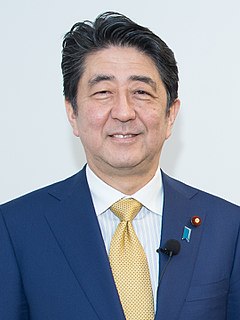
The 48th general election of members of the House of Representatives took place on 22 October 2017. Voting took place in all Representatives constituencies of Japan – 289 single-member districts and eleven proportional blocks – in order to appoint all 465 members of the House of Representatives, the lower house of the then 707-member bicameral National Diet of Japan. Incumbent Prime Minister Shinzō Abe's governing coalition of the Liberal Democratic Party (LDP) and Komeito retained their seats in light of what was perceived as weak opposition, winning his fourth term in office and holding on to the two-thirds supermajority in order to revise the war-renouncing Article 9 of the Japanese Constitution.

The 24th regular election of members of the House of Councillors was held on Sunday 10 July 2016 to elect 121 of the 242 members of the House of Councillors, the upper house of the 717-member bicameral National Diet of Japan, for a term of six years. As a result of the election, the LDP/Komeito coalition gained ten seats for a total of 146, the largest coalition achieved since the size of the house was set at 242 seats.

The 25th regular election of members of the House of Councillors will be held on July 2019 to elect 124 of the 245 members of the House of Councillors, the upper house of the then 710-member bicameral National Diet of Japan, for a term of six years.
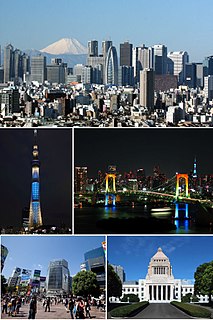
Tokyo, officially Tokyo Metropolis, one of the 47 prefectures of Japan, has served as the Japanese capital since 1869. As of 2018, the Greater Tokyo Area ranked as the most populous metropolitan area in the world. The urban area houses the seat of the Emperor of Japan, of the Japanese government and of the National Diet. Tokyo forms part of the Kantō region on the southeastern side of Japan's main island, Honshu, and includes the Izu Islands and Ogasawara Islands. Tokyo was formerly named Edo when Shōgun Tokugawa Ieyasu made the city his headquarters in 1603. It became the capital after Emperor Meiji moved his seat to the city from Kyoto in 1868; at that time Edo was renamed Tokyo. Tokyo Metropolis formed in 1943 from the merger of the former Tokyo Prefecture and the city of Tokyo. Tokyo is often referred to as a city but is officially known and governed as a "metropolitan prefecture", which differs from and combines elements of a city and a prefecture, a characteristic unique to Tokyo.

New Delhi is an urban district of Delhi which serves as the capital of India and seat of all three branches of the Government of India.

Jawaharlal Nehru University (JNU) is a public university located in New Delhi, India.
